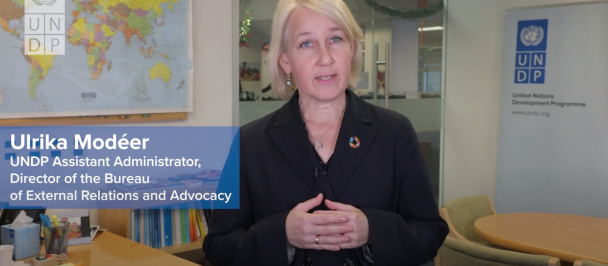UN Development Programme and Economic and Social Commission for Western Asia warn that up to 16 years of human development could be wiped out
Poverty in the State of Palestine set to soar by more than a third if war continues for a second month
9. November 2023

According to projections of the assessment, a third month of war would see poverty increase by almost 45 percent, raising the number of additional people pushed into poverty to more than 660,000, while the decrease of GDP will reach 12.2 percent with total losses of US$2.5 billion.
New York – If the war in Gaza continues for a second month the poverty rate in the State of Palestine will soar by 34 percent, thrusting nearly half a million additional people into poverty, as the Gross Domestic Product (GDP) plummets by 8.4 percent—a loss of US$1.7 billion—according to initial estimates by the United Nations Development Programme (UNDP) and the Economic and Social Commission for Western Asia (ESCWA).
In a rapid assessment released today, entitled ‘The Gaza War: Expected Socio-Economic Impacts on the State of Palestine’, the authors estimate that, as the war hit the one-month mark, poverty had risen by 20 percent and GDP had declined by 4.2 percent. The assessment also underscores that the International Labour Organization estimates that 390,000 jobs have already been lost.
“The unprecedented loss of life, human suffering, and destruction in the Gaza Strip is unacceptable. UNDP joins the UN Secretary-General’s calls for an immediate humanitarian ceasefire; the release of all hostages; and humanitarian access to allow life-saving aid to reach civilians at the scale needed,” said Achim Steiner. “This assessment alerts us that the impacts of this war will also have long-lasting effects and will not be confined to Gaza. On top of the humanitarian catastrophe we see unfolding, there is also a development crisis. The war is rapidly accelerating poverty in a population already vulnerable before this crisis hit.”
According to projections of the assessment, a third month of war would see poverty increase by almost 45 percent, raising the number of additional people pushed into poverty to more than 660,000, while the decrease of GDP will reach 12.2 percent with total losses of US$2.5 billion. The assessment warns of a sharp decline in the Human Development Index, UNDP’s summary measure of wellbeing, setting development in the State of Palestine back by between 11 to 16 years, and in Gaza by 16 to 19 years, depending on the intensity of the conflict.
“A ceasefire and sustained flow of humanitarian assistance would produce an immediate and tangible alleviation of suffering and reduce deprivation levels for hundreds of thousands of Palestinian families: this is an essential first step,” said ESCWA Executive Secretary Rola Dashti. “Economic recovery in Gaza following a ceasefire will not be immediate, considering the large-scale displacement of the population, the massive levels of destruction and uncertain access to resources, including materials and equipment owing to the siege on Gaza,” she affirmed.
With almost 1.5 million people in Gaza internally displaced since the beginning of the war and the massive destruction of houses reportedly destroyed or damaged, the assessment predicts that the economic downturn will further exacerbate the catastrophic humanitarian situation and will make recovery prospects challenging and slow.
The assessment compiles data and employs various analytical tools, including rapid satellite damage appraisals, night-time light satellite imagery and Computable General Equilibrium (CGE) economic modelling, to simulate the impacts of the war in Gaza on the entire occupied Palestinian territory at the one-month mark and for two-month and three-month scenarios.
Full report
To see the report in full in English (available after 12.01 pm EST 9 November), please visit:
To see the report in full in Arabic (available after 12.01 pm EST 9 November), please visit:
For more information and to arrange interviews, please contact:
Dylan Lowthian | Head of Media Relations | Bureau for External Relations & Advocacy | dylan.lowthian@undp.org
Noeman AlSayyad | Strategic Communications Advisor | Regional Bureau for Arab States noeman.alsayyad@undp.org
Stanislav Saling | Communications Specialist | Human Development Report Office | stanislav.saling@undp.org
Mette Fjalland, Partnership Specialist, UNDP Nordic Representation Office | Mette Fjalland | Mobile: +45 5183-6228 Email: mette.fjalland@undp.org
ESCWA
Maryam Sleiman | Communication Unit (CU) | sleiman2@un.org
Rania Harb | Communication Unit (CU) | harb1@un.org
NOTES TO EDITORS
Initial estimations of the impacts of war – relative to pre-war levels or 2023 expectations:
- At one month
- Palestinian GDP will have declined by 4.2 percent or a US$857 million loss.
- Poverty will have increased by 19.5 percent from 26.7% to 31.9% of the population.
pushing 285,139 more people into poverty approx. from 1,464,081 to 1,749,220 individuals.
- After two months
- Palestinian GDP will decline by 8.4 percent or a US$1.7 billion loss.
- Poverty will increase by 34.1 percent from 26.7% to 35.8% of the population.
pushing 498,994 more people into poverty approx. from 1,464,081 to 1,963,075 individuals.
- After three months
- Palestinian GDP will decline by 12.2 percent or a US$2.5 billion loss.
- Poverty will increase by 45.3 percent from 26.7% to 38.8% of the population.
pushing 663,497 more people into poverty approx. from 1,464,081 to 2,127,578 individuals.
- Unemployment
The assessment references International Labour Organization estimates that 390,000 jobs have already been lost, including
- In Gaza: 61 percent of employment equivalent to 182,000 jobs
- In the West Bank: 24 per cent of employment equivalent to 208,000 jobs.
- Human Development Index
- The assessment calculates the HDI for the State of Palestine under 4 scenarios based on assumptions of expected reduction in life expectancy, decrease in expected years of schooling, and decline in the gross national income.
For the State of Palestine
HDI is expected to be setback by 11 years (2012 level of 0.700) in the least intense impact scenario and by 16 Years (2007 level of 0.674) in the most intense impact scenario.
- It also calculates the HDI separately for Gaza and the West Bank based on 2 scenarios that account for the differential expected impacts.
For Gaza
HDI is expected to be setback by 16 years (2007 level of 0.674) in the least intense impact scenario and by 19 Years (2004 level of 0.656) in the most intense impact scenario.
For the West bank
HDI is expected to be setback by 8 years (2015 level of 0.718) in the least intense impact scenario and by 11 Years (2012 level of 0.706) in the most intense impact scenario.

 Locations
Locations


